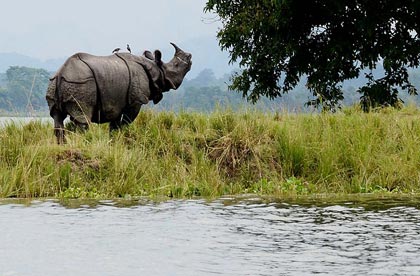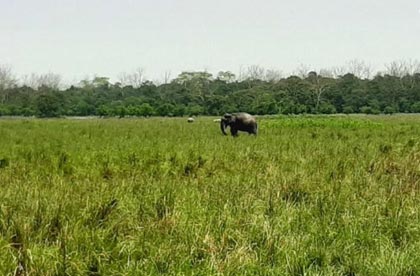Kaziranga National Park is located in the north-eastern state of Assam, India. It is a UNESCO World Heritage Site and is known for its unique landscape and diverse river systems. Let's explore the Kaziranga landscape and rivers in more detail here:
Kaziranga National Park is situated in the floodplains of the Brahmaputra River, which creates a unique ecosystem. The park covers an area of approximately 430 square kilometres and is characterized by vast grasslands, marshes, and dense forests. The landscape features tall elephant grass, scattered trees, and shallow water bodies called Beels. These Beels are flooded during the monsoon season, providing additional habitats for the wildlife.


Several rivers and water bodies are found in and around Kaziranga National Park. The most prominent river is the Brahmaputra, which flows along the northern boundary of the park. The Brahmaputra is one of the major rivers of Asia and plays a crucial role in shaping the landscape of the region. It brings rich alluvial soil from the Himalayas, which contributes to the fertility of the floodplains and supports the growth of diverse vegetation.
Apart from the Brahmaputra, Kaziranga is also crisscrossed by numerous smaller rivers and streams, such as the Diphlu River, Mora Diphlu River, and Mora Dhansiri River. These water bodies provide additional water sources and habitats for various aquatic species in the park.
The rivers and water bodies in Kaziranga are essential for the survival of the park's iconic inhabitants, especially the Indian one-horned rhinoceros. During the monsoon season, when the Brahmaputra overflows, large portions of the park get submerged. The highlands and elevated areas act as a refuge for the animals, allowing them to adapt to the changing water levels.
Overall, the landscape of Kaziranga, with its unique grasslands, marshes, and river systems, creates a diverse ecosystem that supports a wide range of plant and animal species. The rivers not only contribute to the park's natural beauty but also play a vital role in maintaining the ecological balance of the region.
Rivers and landscapes play crucial roles in the significance and value of national parks for several reasons:
Its Biodiversity and Ecosystems: Rivers and landscapes are home to diverse ecosystems that support a wide variety of plant and animal species. National parks often contain unique habitats that are essential for the survival of numerous species, some of which may be endangered or rare. Rivers provide a source of freshwater for the surrounding ecosystems, serving as lifelines for plants, animals, and microorganisms.
Enhances Scenic Beauty: National parks are known for their natural beauty, and rivers and landscapes contribute significantly to this aesthetic appeal. The flowing waters of rivers, combined with diverse landscapes such as mountains, canyons, valleys, and forests, create stunning vistas that attract visitors from around the world. The scenic beauty of national parks enhances people's well-being and provides opportunities for recreation and inspiration.
Cultural and Historical Significance: Rivers and landscapes often hold cultural and historical significance for local communities and indigenous peoples. They can be associated with traditional practices, spiritual beliefs, and historical events. National parks provide opportunities for preserving and sharing these cultural and historical connections, allowing visitors to learn and appreciate the heritage of the area.
Contributes to Hydrological Functions: Rivers within national parks serve important hydrological functions, such as regulating water flow, recharging groundwater, and filtering pollutants. These natural processes contribute to the overall health of the watershed and downstream ecosystems. Protecting rivers and landscapes within national parks helps maintain clean water sources, benefiting both wildlife and human communities.
Recreation and Tourism: Rivers are often popular recreational destinations within national parks, offering opportunities for activities such as fishing, boating, kayaking, and rafting. The surrounding landscapes provide ideal settings for camping, hiking, wildlife watching, and photography. By preserving and managing these natural features, national parks provide spaces for people to relax, enjoy nature, and engage in outdoor activities.
Research and Education: National parks serve as living laboratories for scientific research, allowing experts to study ecosystems, wildlife, geology, and other aspects of the natural world. Rivers and landscapes provide valuable research opportunities and contribute to our understanding of ecological processes, climate change, and the impacts of human activities. National parks also play a crucial role in environmental education, providing opportunities for visitors to learn about the importance of conservation and sustainable practices.
In summary, rivers and landscapes are vital components of national parks due to their ecological, aesthetic, cultural, and recreational values. They contribute to the overall biodiversity, scenic beauty, and cultural heritage of these protected areas, while also fulfilling important hydrological functions and providing opportunities for research, education, and tourism.